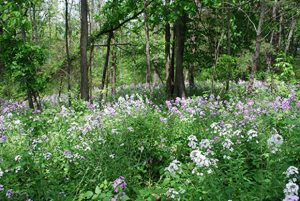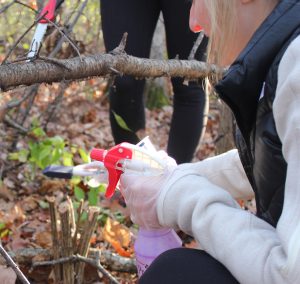By Allene Smith, Land Steward

Herbaceous invasive dame rockets. Photo by Judy Heady
The conservation community’s effort to slow or stop the spread of invasive plants is often referred to in terms of warfare: invasive plants are the enemy, and we must combat them with every weapon imaginable from loopers to herbicides. Land management is a battle of good (native) against evil (invasive). Invasive plants are portrayed with a certain malice, as if they take pleasure in outcompeting the peacefully innocent native species and wreaking havoc on the local landscape. Stewardship is a mythic battle, to return our home landscapes to a state approximating “original.”
Language matters. Relating stewardship to warfare undermines our opportunity to heal both our history and future with the land. Legacy’s Land Protection Specialist Remy Long identifies the role of stewardship as “the human hand gently supporting the inherent strength of our natural world.” I believe we need to thread patience back into our storytelling around stewardship, and acknowledge that we do not—and will not—have the final word as to what belongs in the places we call home.

Applying pesticides to autumn olive at Sharon Hills Nature Preserve.
On Legacy’s preserves, we use prescribed fire along with manual and chemical control methods (cutting and herbicide) not as weapons in an ongoing war, but as tools to shift the balance of resource availability. At our Sharon Hills Nature Preserve, spring fires have killed the above-ground portions of autumn olive (Elaeagnus umbellata) shrubs in certain high-priority management units. As the woody tissue dies, the shrubs lose their leaves, allowing the sun’s light and warmth to once again reach the forest floor. Ground layer vegetation, such as hairy sweet cicely (Osmorhiza claytonii) and naked tick-trefoil (Hylodesmum nudiflorum) and seedlings of native hardwoods like white oak (Quercus alba) and pignut hickory (Carya glabra), are now able to make their way into the light. With the balance shifted, the native plants and the systems they support have a little more purchase on this slippery slope of succession in our modern world.
With herbicide, prescribed fire, manual removal, and other tools, we can maintain and advance that shift in resource availability to improve conditions for native plants. As conditions improve, species abundance and diversity can increase, and, with time, a rekindled cohesive community forms a barrier to invasion all its own. In this way, I think of stewardship as a nudge toward self-sustenance.
I wish you luck as you explore what it means for you to be a steward of the land. If you need a place to get in touch with your inner steward, there’s plenty of “nudging” to do at the Lloyd and Mabel Johnson Nature Preserve to support our prairie restoration efforts. I would love to work with you!

 RSS Feed
RSS Feed